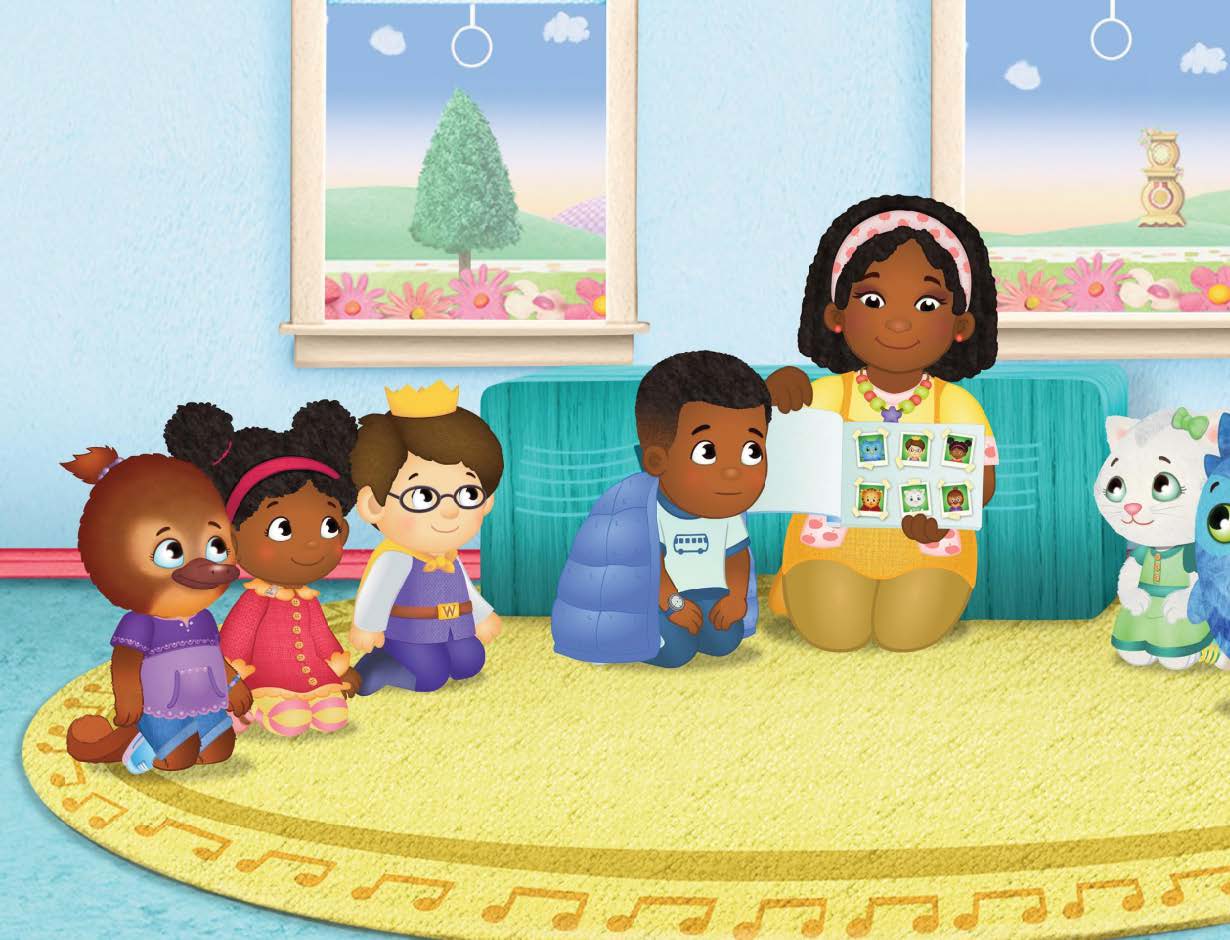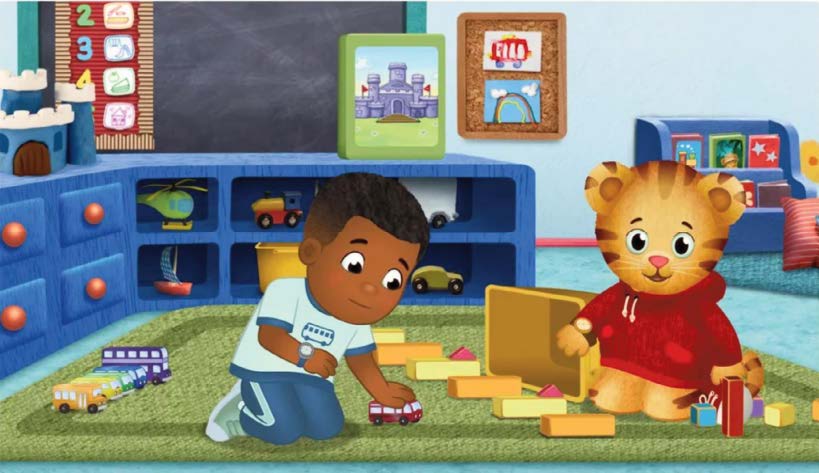
WON'T YOU BE MY NEIGHBOR?: Daniel Tiger and his pals from the Neighborhood get to know their new friends Max and his sister Amira in new episodes of Daniel Tiger's Neighborhood, premiering April 5 on PBS KIDS (check local listings).
DANIEL TIGER'S NEIGHBORHOOD INTRODUCES MAX, A CHARACTER ON THE SPECTRUM
BY WESLEY DOTSON
Relationships are the building blocks of happiness. Connecting with others enhances our quality of life, speeds our recovery when sick, and lowers our risk of depression and anxiety. People with stronger relationships have higher rates of employment, earn more, report higher levels of satisfaction in their work and personal lives, and handle stress and adversity with more resilience. Most of us will spend our entire lives working to navigate many relationships. It is difficult but valuable work.
Teaching children how to build and maintain relationships of all kinds, then, is an important priority for those of us who work with them. The good news is that we know a lot about how relationships form and what kinds of social and emotional skills set the stage for success in achieving that goal. Even better, the social and emotional skills needed to build and maintain relationships can be taught and most children want to learn them.One of the most damaging and persistent myths about children on the autism spectrum is that their struggle with social skills indicates a fundamental lack of interest in other people, or an absence of desire to interact with them. Children with autism are children. They want friends and to be included. Teenagers with autism are teenagers. They want to hang out, join groups of people who share their interests, and find first boyfriends and girlfriends. Adults with autism are adults. They want everything you or I want: to have a job they find meaningful, to enjoy intimacy in its varied forms with someone who loves them, to contribute and participate.
For children on the autism spectrum, a struggle with social communication and difficulty building and maintaining relationships are core aspects of their experience. It is hard for an individual on the spectrum to notice body language, to respond to openended questions, or recognize the give and take of a free-flowing conversation. Do not equate difficulty with doing those things with a lack of motivation to learn, however. How do we help them do so, then? All children learn skills best when those skills are openly taught and talked about. We must name and recognize things like emotions and emotional responses to situations. We must acknowledge the challenge in navigating social interactions so that by naming them we may better manage them. We need to identify the skill we want them to learn, tell them what it looks like, show them where and when to use it, and then model what it looks like and let them practice in a safe environment.
Children's television shows can contribute to kids learning these important social and emotional skills by including those elements in their program design. Shows like Daniel Tiger's Neighborhood do so mindfully and intentionally. Each episode introduces a common situation facing children, such as getting angry or dealing with disappointment, and teaches the characters how to handle that situation. By showing experiences that all children have, and offering a model of how to process and navigate the experience, each episode gives parents and teachers a tool that demonstrates how to to talk to the children about their emotions within a shared experience of watching the show. It can provide a way to have a difficult conversation in a less threatening context, and at a time the child is engaged and interested.
Parents who want to take advantage of the opportunity provided by programs such as Daniel Tiger's Neighborhood can do so "Children with autism are children. They want friends and to be included. Teenagers with autism are teenagers. They want to hang out, join groups of people who share their interests, and find first boyfriends and girlfriends." both while watching episodes with their children and when situations occur in real life. During an episode, ask your child if they have ever felt the same way as the characters on the show. Tell them stories of times you have felt that way. Tell them about times they can use the skill themselves. Ask them to show you how they would do the skill when the show asks them to do so (Daniel is very good at inviting your child to pretend with him). Then, when the episode is over, look for opportunities to remind the child of the lesson. If you just finished watching an episode about trying new foods, for example, you could plan to offer a new vegetable at dinner that night. Then, ask them what Daniel Tiger would say if he was asked to try something he had never eaten before.
Sing to them, "We gotta try new food cause it might taste good!" and then tell them they have a chance to do the same thing when you introduce the vegetable at the table. Or, if you see your child becoming angry, tell them that it is ok to be mad, and prompt them to calm down like Daniel Tiger by taking a deep breath and counting to four. Help them connect the strategies they see and learn in the show to the situations that happen to them at school and home. Show them how acting like Daniel or Max or Katerina works for them too.
For children with autism who struggle to notice and respond to social cues, structured teaching interactions with clear descriptions and visual models work extremely well in helping them see what is important and respond appropriately. My own research into how children with autism respond to episodes of Daniel Tiger's Neighborhood shows that for the children who enjoy the show, they engage with the show more often than other cartoons and can learn directly from the show.
In one study, we showed episodes of Daniel Tiger's Neighborhood about trying new foods and stopping play when it was time to go to two young children with autism who would previously not do either of those things. After several viewings of the episodes, both children began trying new foods and stopping play when asked. One of the more interesting aspects of that study was the report by one parent that, after watching the show with us, her child would sing the songs from the two episodes at appropriate times with his family, such as when they were at the grocery store choosing food.

YOU ARE SPECIAL: Characters like Max show that autism can manifest in many ways, helping the wider community better understand the amazing uniqueness of people on the spectrum while also increasing the chance that someone on the spectrum will see themselves in the character.
In my research, one thing that has become clear is that if a show is to be engaging and effective at helping a child learn, the child must first enjoy the show. If a child will not initially watch it for even a few minutes, it will not work as a teaching tool. But if a child is interested in and watching a show, it indicates they notice what is going on, and a perceptive parent or teacher can use that interest to talk to and guide the child through learning the lessons of the episode. This is where representation and identity matter. Children are more likely to find interesting those things they can relate to and that are relevant and meaningful to them. Having characters on a television show that a child can identify with and feel connected to makes it more likely the child will enjoy and watch the show. If they enjoy and watch the show, it will be a better tool for teaching and learning. A more diverse and representative cast of characters will appeal to and benefit a larger number of children and their families.
That is why it is so exciting that Max has joined Daniel Tiger's Neighborhood. The introduction of a character on the spectrum to a show already so well designed and educational can only improve the impact and potential of each episode. Max also helps address one of the biggest challenges for groups trying to improve the representation of the autism spectrum in media; that autism itself is a spectrum. Individuals on the autism spectrum exhibit a wide range of behaviors and characteristics, making it impossible for one single character on a show or in a movie to capture the diversity of the experience of autism for everyone impacted or touched by it.
The goal is for each character to have individual authenticity and sincerity. When multiple characters such as Max, or Julia on Sesame Street, show that autism can manifest in many ways, it helps the wider community better understand the amazing uniqueness of people on the spectrum while also increasing the chance that someone on the spectrum will see themselves in one of the characters. Children with autism are looking for themselves in the books they read and the shows and movies they watch.
For their sake, greater variety is better. More representation also reflects the reality that autism spectrum disorder is one of the fastest-growing diagnoses in the country, and more children are diagnosed with autism today than ever before. According to the Centers for Disease Control and Prevention, 1 in 54 children are identified with autism spectrum disorder. Children with autism participate and are visible in more public spaces than ever before. They want, need, and deserve the same opportunities to build, maintain, lose, rediscover, and grow relationships as everyone else. •
ABOUT THE AUTHOR:
Wes Dotson is an Associate Professor in the Special Education Department in the College of Education at the University of Missouri and the Director of Applied Behavioral Intervention Services at the Thompson Center for Autism & Neurodevelopmental Disorders. After earning his Ph.D. in Behavioral Psychology in 2010 from the University of Kansas, he spent ten years at Texas Tech University and the Burkhart Center for Autism before coming to Columbia. He has been a BCBA since 2008. He has spent over 19 years in special education and clinical practice, working with individuals with autism and other developmental disabilities of all ages across school, clinic, home, community, and residential treatment settings. His primary areas of research and practice are social skills, relationship development, and successful life outcomes for adolescents and young adults with autism, as well as the preparation of teachers and other professionals to work successfully with individuals on the spectrum. Dotson spearheaded the Texas Tech University study on Daniel Tiger's Neighborhood and autism.